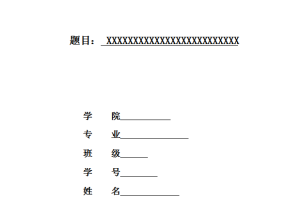摘 要
随着信息环境的快速发展,我国企业的集团化趋势越来越明显。财务管理模式对于企业集团的发展起着至关重要的作用,因此,企业集团财务管理模式的构建研究具有重要的现实意义。
本文以企业集团财务管理模式的理论为出发点,首先介绍了企业集团的定义和特征,然后对企业集团财务管理模式的特点和形式进行阐述。接着本文着重对华菱集团进行分析,通过分析华菱集团现在的财务管理问题,来构建华菱集团新的财务管理模式。并针对华菱集团的现状,结合其财务管理的目标和原则,以及财务管理模式的影响因素,创新性地提出了集约化财务管理模式的概念,意在通过资金集中管理、加强财务公司的作用和全面预算管理等方法来实现华菱集团的快速发展。此外,本文对与华菱集团类似的企业集团构建财务管理模式还有一定的指导意义。
关键词:企业集团 财务管理模式 集约化
ABSTRACT
With the rapid development of economy, the collectivization trend of the enterprises in our country is more and more obvious. Financial management mode plays an important role on the development of enterprise group. Therefore, the research on the construction of enterprise group financial management mode has important practical significance.
Thus paper starts from the theory of enterprise group financial management mode. First of all, this paper introduces the definition and characteristics of enterprise group. Secondly, it explains the characteristics and forms of enterprise group financial management mode. Then this paper focuses on the analysis of the enterprise group, which is named Hua Ling. It analyzes the financial management problems of Hua Ling in order to build a new financial management mode,which is suitable for the enterprise group of Hua Ling. Based on the present situation of Hua Ling, combined with its financial management objectives and principles, as well as the influence factors of the financial management mode, this paper puts forward the concept of intensive financial management mode creatively. By this way, the paper intends to make financial centralized management, strengthen the function of financial companies and comprehensive budget management to realize the rapid development of Hua Ling. Besides, it is meaningful on the construction of enterprise group financial management mode for the enterprise group which is similar with Hua Ling.
Key words: enterprise group financial management mode intensive
目 录
前 言…………………………………………………………………………………………………….. – 1 –
1 企业集团财务管理模式概述…………………………………………………………. – 2 –
1.1 企业集团的概念和特征………………………………………………………………….. – 2 –
1.1.1 企业集团的定义………………………………………………………………………… – 2 –
1.1.2 企业集团的特征………………………………………………………………………… – 2 –
1.2企业集团财务管理模式的定义………………………………………………………… – 3 –
1.3 企业集团财务管理模式特点…………………………………………………………… – 3 –
1.3.1 母公司负责构建财务管理模式……………………………………………………… – 3 –
1.3.2 强调适应性和协调性………………………………………………………………….. – 4 –
1.3.3 财务管理模式具有杠杆效应………………………………………………………… – 4 –
1.4 企业集团财务管理模式的形式……………………………………………………….. – 4 –
1.4.1“集权型”财务管理模式…………………………………………………………………. – 4 –
1.4.2“分权型”财务管理模式…………………………………………………………………. – 4 –
1.4.3“平衡型”财务管理模式…………………………………………………………………. – 4 –
1.4.4 三种财务管理模式的利弊比较分析……………………………………………….. – 5 –
2 华菱集团财务管理的现状……………………………………………………………… – 5 –
2.1 华菱集团的基本情况……………………………………………………………………… – 5 –
2.1.1 华菱集团简介…………………………………………………………………………… – 5 –
2.1.2 华菱集团组织结构及组织关系……………………………………………………… – 6 –
2.1.3 华菱集团的财务状况………………………………………………………………….. – 7 –
2.2 华菱集团现有财务管理模式存在的问题…………………………………………. – 9 –
2.2.1 法人治理结构混乱…………………………………………………………………….. – 9 –
2.2.2 资金管理不到位………………………………………………………………………. – 10 –
2.2.3 华菱集团内部资本市场配置无效率……………………………………………… – 11 –
2.2.4 预算管理不全面………………………………………………………………………. – 14 –
3 构建华菱集团财务管理模式的目标和原则及相关影响因素 – 14 –
3.1 构建华菱集团财务管理模式的目标……………………………………………….. – 14 –
3.1.1 保证企业集团实现规模信息环境…………………………………………………. – 14 –
3.1.2 发挥财务资源的聚合优势………………………………………………………….. – 15 –
3.1.3 强化企业集团财务监控力度……………………………………………………….. – 15 –
3.1.4 加强企业集团内部管理的协调性…………………………………………………. – 15 –
3.2 构建华菱集团财务管理模式的原则……………………………………………….. – 15 –
3.2.1 成本效益原则………………………………………………………………………….. – 15 –
3.2.2 重视内控原则………………………………………………………………………….. – 15 –
3.2.3 目标一致性原则………………………………………………………………………. – 15 –
3.2.4 风险收益平衡原则……………………………………………………………………. – 16 –
3.3 华菱集团财务管理模式构建的相关影响因素分析………………………….. – 16 –
3.3.1 企业集团的内外部环境……………………………………………………………… – 16 –
3.3.2 企业集团的发展阶段………………………………………………………………… – 16 –
3.3.3 企业集团文化和发展战略………………………………………………………….. – 17 –
3.3.4 子公司的技术要求……………………………………………………………………. – 17 –
3.3.5 地理分布………………………………………………………………………………… – 18 –
4 华菱集团财务管理模式的构建——集约化财务管理模式….. – 18 –
4.1 集约化财务管理模式的含义………………………………………………………….. – 18 –
4.2 构建集约化财务管理模式的必要性……………………………………………….. – 18 –
4.3 华菱集团集约化财务管理模式的具体构建…………………………………….. – 19 –
4.3.1 实行资金集中管理……………………………………………………………………. – 19 –
4.3.2 强化财务公司的财务管控作用……………………………………………………. – 19 –
4.3.3 完善内部资本市场机制……………………………………………………………… – 20 –
4.3.4 推行全面预算管理……………………………………………………………………. – 21 –
结 束 语……………………………………………………………………………………………….. – 21 –
参考文献……………………………………………………………………………………………….. – 22 –
后 记……………………………………………………………………………………………………. – 23 –





